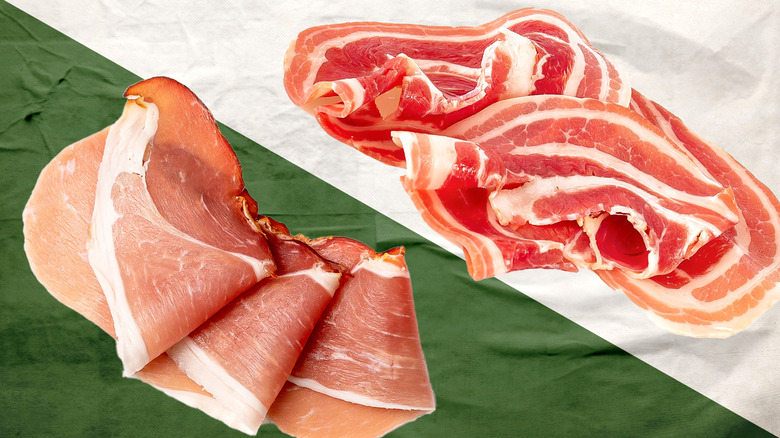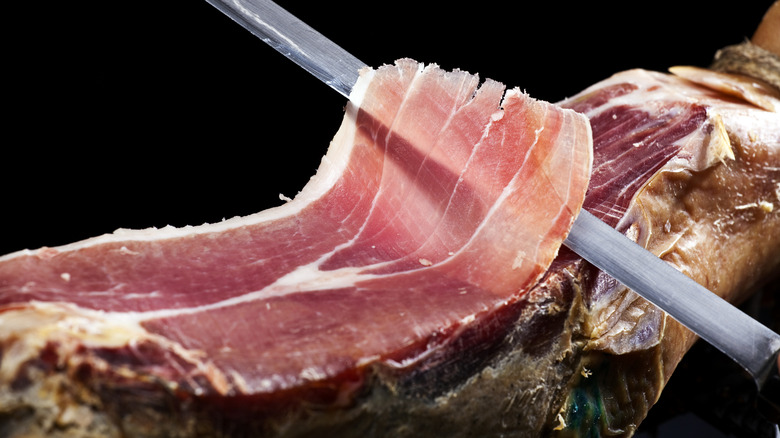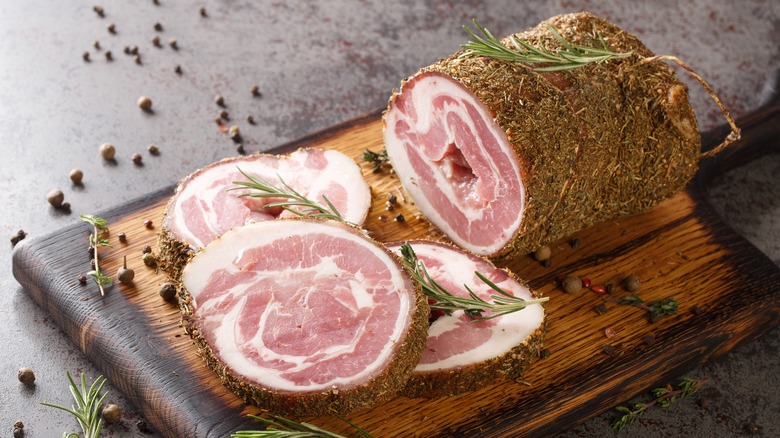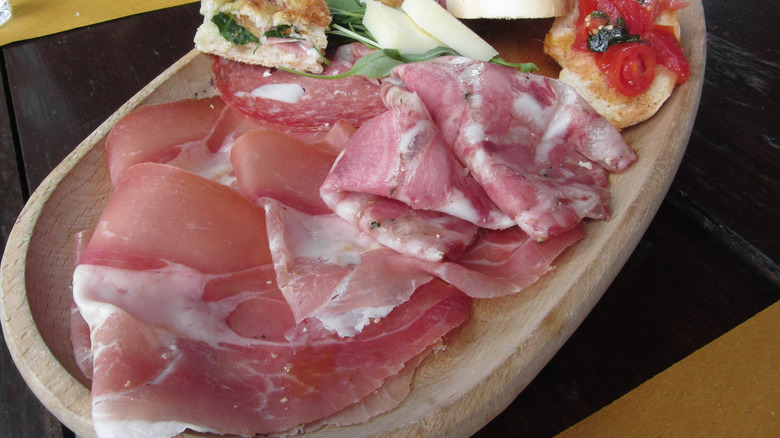The Differences You Should Know Between Prosciutto And Pancetta
With charcuterie boards growing ever more popular, you've likely been eyeing the cured meat section of your grocery with more interest these days. There's a growing bounty of choices and many of the meats might look similar, for example, prosciutto and pancetta – even their names could be confused with each other. They are both cured pork products with Italian heritage but are more different than they seem at first glance.
Pancetta is made from pork belly that's seasoned with salt and various spices, then rolled and cured, often with pepper or other flavorings. It's typically eaten cooked, adding a rich, salty flavor to dishes like pasta or salads. Prosciutto, on the other hand, is made from the hind leg of the pig, dry-cured with salt, and aged for several months at a minimum. It has a delicate, slightly sweet flavor and is usually enjoyed thinly sliced, served as an antipasto or wrapped around fruits or vegetables.
What is prosciutto
Prosciutto is a dry-cured ham with a delicate flavor and melt-in-your-mouth texture. Made from pork leg, like American ham, prosciutto undergoes a careful curing process involving salt and a period of aging, typically lasting anywhere from nine months to two years. The combination of salt and natural yeasts dries and concentrates the flavors of the meat, transforming it into a sweet and savory delicacy intended to be very thinly sliced and eaten as is, uncooked.
Slices of prosciutto have a small margin of fat which provides a contrast to the salty flavor of the cured meat. The oldest, longest-aged prosciutto should be enjoyed by itself to fully taste the complex flavors that time brings to the meat. Younger versions are perfect to serve with appetizers — an Italian classic is a piece of ripe orange-fleshed cantaloupe draped with a slice of prosciutto. The sweet melon and umami-packed pork create a perfect balance of salty and sweet. Prosciutto is also great on pizzas and tossed into pasta. A quick blast of heat will create a crispy texture if you prefer to cook prosciutto — and for an unusual take for your charcuterie board, you can even cook it with a sprinkle of brown sugar for a sweeter meaty taste-sensation.
What is pancetta
Pancetta is made from pork belly — the same fatty cut used for American bacon. The meat is cured with salt and spices, then rolled tightly and allowed to age, but only for a few months, not years. The curing process lends a similar flavor profile to the meat as prosciutto, but the additional spices give a more distinctive, savory flavor. Pancetta has a highly fatty texture, and because the salt is rolled up with the meat instead of just applied to the outside as in prosciutto, it tends to taste quite salty. The meat can be thinly sliced and eaten as is, but it's more commonly diced and cooked to add to pasta dishes and soups.
Pancetta is often used in classic spaghetti carbonara, although many Italians would argue that guanciale is the most traditional pork meat that should be used in the recipe. The salt and umami flavors of pancetta balance the richness of egg yolk and parmesan or pecorino cheese that are swirled through the pasta. As diced pancetta heats up, the fat melts into a perfect clear oil for cooking aromatic vegetables like onions, garlic, and celery, for soups, stews, risotto, and pasta sauces. The rendered pancetta itself can be added back into the dish for added bacony richness and depth of flavor.
The cut of meat differentiates prosciutto and pancetta
While both prosciutto and pancetta are salted and aged pork products, they come from very different cuts of meat. The whole hind leg of pork is salted and hung to age to produce prosciutto. The aging process takes longer because the interior of the meat must fully dry and transform. The leg has some fat marbling and a fatty exterior which is included while slicing the meat, but prosciutto is much higher in lean muscle than pancetta. The salted and rolled pork bellies used to produce pancetta have more interior seasoning and contain about 30% fat, twice as much as prosciutto.
Understanding the muscle and fat ratio will help you pick the right cured meat for your recipe. Uncooked thin slices of both meats can be enjoyed on a charcuterie board. Cooked slices of pancetta are a reasonable substitute for bacon and when it's diced, pancetta also makes a deliciously salty sprinkle on salads. Cooked prosciutto can be very crunchy due to its very lean meat, but when heated lightly while wrapped around a scallop or stuffed date, it adds perfect salty contrast.



